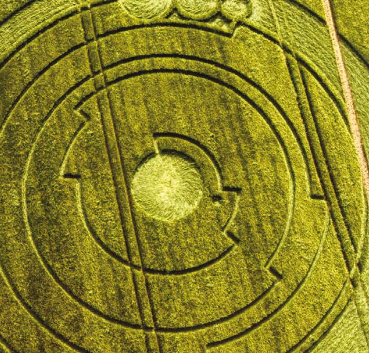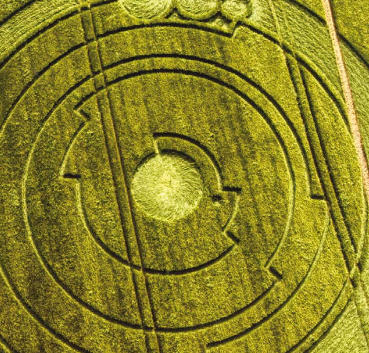 Every year strange and beautiful formations appear in the fields. If you want to know what creates them don’t skip on to the end of this article – you will only be disappointed. GUM explains the phenomenon of the crop circles.
Every year strange and beautiful formations appear in the fields. If you want to know what creates them don’t skip on to the end of this article – you will only be disappointed. GUM explains the phenomenon of the crop circles.
Every British summertime, year in year out, the paper reading public can rely on a number of stories to become the subject of media comment. The weather, obviously, is big news, hottest summer ever/wettest summer ever, either way we are all doomed. Wimbledon, again, every single year. Can they not just give it a break for one summer? But one feature I always look forward to is the staple article with big pictures of the year’s crop circles.
In fact my interest extends some way beyond that; I’ve visited a few circle seasons and seen them up both close and from the air. Even so I would be flattering myself to say I was a bone fide ‘croppie’. There are various theories that try to explain these formations: aliens, electromagnetism, earthly spirits, freak weather, and of course people. In 1991 Doug Bower and Dave Chorley announced to the media that they had created every one of the 2000 odd circles that had appeared since 1978, starting a trend in circle making in the South of England. However they later retracted a number of their claims when their ability to make a ‘good’ crop circle for the media was called into question and they could not prove their claims.
The fact is no one can prove how a great number of the most impressive circles were made or by whom, and their perfection in design and execution is mystifying.
I spoke to two authorities on the subject, first Michael Glickman, a geometrician and commentator, author and lecturer on the phenomenon, and also John Michell, a writer on topics as diverse as crop circles, sacred geometry, Plato, and the authorship of Shakespeare. Both Michael and John strongly believe that a great many crop circles are not man-made.
When I asked how I might go about introducing the mystery of crop circles, John had some sound but esoteric advice. He told me: “When you don’t know you can’t say you do know, the only approach you can take is to look at their features.” Therefore, it seems that the only reasonable approach would be to examine what was visible to all, namely their design and construction.
It has been shown on numerous occasions that it would be possible to make a crop circle with a small team of people. The simplest method would be to flatten the crop with a device wound around a pole in the centre of the circle. Nonetheless, being in a fresh circle and seeing how it has been made is very exciting as one will find that the stalks of the folded wheat flow through the formation in a specific direction and that the folds are certainly folds, rather than breaks, as if untouched by human hands. It is also often impossible to see the whole formation from the ground as the fields tend to cover uneven land. John pointed out an interesting anomaly in the theory of human circle construction, explaining that it would be impossible for a group of people to make circles such as those which have been found where only the circumference is flattened. “You can’t make a circle without a centre. If the centre is undisturbed it is hard to explain how the circle is created, it’s not possible.”
Michael, on the other hand, is of the view that the secret of the phenomenon lies much more in the design than the construction. “I’ve been looking at this assiduously for 20 years and I can spot a man-made circle in three million. I look at aerial photographs; from these you can study the quality and geometry of the design. The actual construction is very impressive but the truth is that the hoaxers have got very good over the years at faking the detail, but they’d need to be prodigious geniuses to replicate the profound geological and numeric construction of the design.
“It’s a question of what you put onto the drawing board. The intuition, the inspiration, the inventiveness that comes year after year after year is beyond human ability. The plan is too long term and the enterprise is too long-term.”
One such example of truly original design was “the Ratchet” at Barbury castle in 2008. Michael was one of the first to crack the code, realising that the formation was a pictorial representation of pi. As he described it to me I wondered whether he was also the first to condense the explanation into such neat terms.
“It was one of the most breathtaking moments of my existence. I’d been looking at this formation for a week and I suddenly twigged what was going on and worked it all out. My colleague Karen Douglas called me up and said, ‘Perhaps that dot near the middle of the field is a decimal point?’ and I realised that you could turn it into a decimal point and give a numerical value to each of the arcs. The way it works is very interesting because radially it has tenfold geometry, like a pizza divided into ten pieces, and concentrically it is tenfold, like a pebble dropped into a pond.
“They use this tenfold geometry like a grid, on which they could outline their stepped spiral, and each arc of that spiral takes in a specific number of 36 degree pizza slices. So the first arc is three, then there’s the dot, then the second arc is one, then four and then one and five and I followed it all the way round and understood it was pi.”
John Michell was equally fascinated by the Ratchet, and the self-evident validity of circle geometry: “I think its one of the most interesting ones I’ve seen. These expressions of mathematical truths have never thought of before. They are all original puzzles that have truth in them. All truths are geometric or numerical in nature. Number is the nearest thing we have to eternal truth.”
Having investigated the geometry of the circles for so long, I realised both John and Michael are remarkably disinterested in who actually made the circles, though both agree there is an element of the miraculous in many of them.
When asked about aliens and spirits Michael politely remarked that it is not his area of expertise. John also warned me of the pseudoscience that is used to explain (or enrich) the mystery of crop circles saying, “no one really makes any scientific attempt to investigate these things. People already know what they want to discover. They get obsessed with who’s doing it and the hoax aspect of it, then they get confused then they lose the subject.”
I wholeheartedly agree with John on this point, and endeavour not to try ascribing some mundane solution to such a huge and picturesque mystery. Looking for the type of evidence that would stand up in court seems pointless – it’s not a question of ‘whodunit?’ but of what message it contains. My love of circles comes not from knowing who or how, but from trying to unravel the codes and from a simple enjoyment of beauty and symmetry. Any explanation I have heard for the phenomenon has required a good deal of speculation, even from the cynics and ‘hoaxers’, and at the end of the day I’m not that desperate to know anyway.

